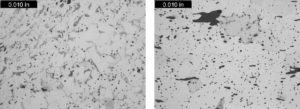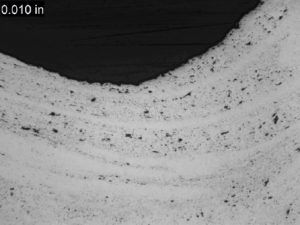Infrastructure Upgrades – Materials Analysis
MATERIALS LABORATORY CASE STUDY 4
THE PROBLEM
Structural Integrity received a section of an original star member from one of Austin’s Moonlight Towers (Figure 1). The material was suspected to be a ductile or malleable cast iron and the company refurbishing the towers needed to determine a suitable replacement material. SI was asked to perform materials testing on the sample to determine its chemical composition, measure its tensile strength, and evaluate the microstructure to determine the material type.

Figure 1. The star member shown in the as-received condition A
THE SOLUTION
A portion of the star member was submitted for tensile testing and quantitative chemical analysis. Based on the compositional analysis, and particularly the carbon content, the star member is a low carbon steel and not a cast iron. The composition is consistent with UNS G10050 or ASTM A29 Grade 1005. The material was found to have a tensile strength of about 50 ksi and a yield strength of about 30 ksi.
A cross-sectional sample from the star member was prepared for evaluation using standard laboratory techniques. The prepared sample was examined using a metallurgical microscope for evaluation of the microstructure, which is shown in Figure 2. The microstructure consisted of perlite, nonmetallic inclusions, and casting voids/flaws in a ferrite matrix. The microstructure is consistent with a low carbon steel and is not indicative of a ductile or malleable cast iron. The microstructure also showed significant deformation, presumably from forming the star shape (Figure 3). It is not clear if the casting voids/flaws present in the material indicate the material was originally cast and then formed, or if they are just indicative of the quality of the material at the time of manufacture (i.e., the component is not a casting).
With the information from this analysis, the company performing the refurbishment was able to select a suitable material to replace the old, original Moonlight Tower star members.

Figure 2. The typical star member microstructure A

Figure 3. Deformation in the microstructure
MOONLIGHT TOWERS
The moonlight towers in Austin, Texas, are the only known surviving moonlight towers in the world. They are 165 feet (50 m) tall and have a 15-foot (4.6 m) foundation. A single tower originally cast light from six carbon arc lamps, illuminating a 1,500-foot-radius (460 m) circle brightly enough to read a watch. In 1894, the City of Austin purchased 31 used towers from Detroit. They were manufactured in Indiana by Fort Wayne Electric Company and assembled onsite. When first erected, the towers were connected to electric generators at the Austin Dam, completed in 1893 on the site of present-day Tom Miller Dam. In the 1920s their original carbon-arc lamps, which were exceedingly bright but time-consuming to maintain, were replaced by incandescent lamps, which gave way in turn to mercury vapor lamps in the 1930s. The mercury vapor lamps were controlled by a switch at each tower’s base. During World War II, a central switch was installed, allowing citywide blackouts in case of air raids. (source: Wikipedia)
RELATED MATERIALS












